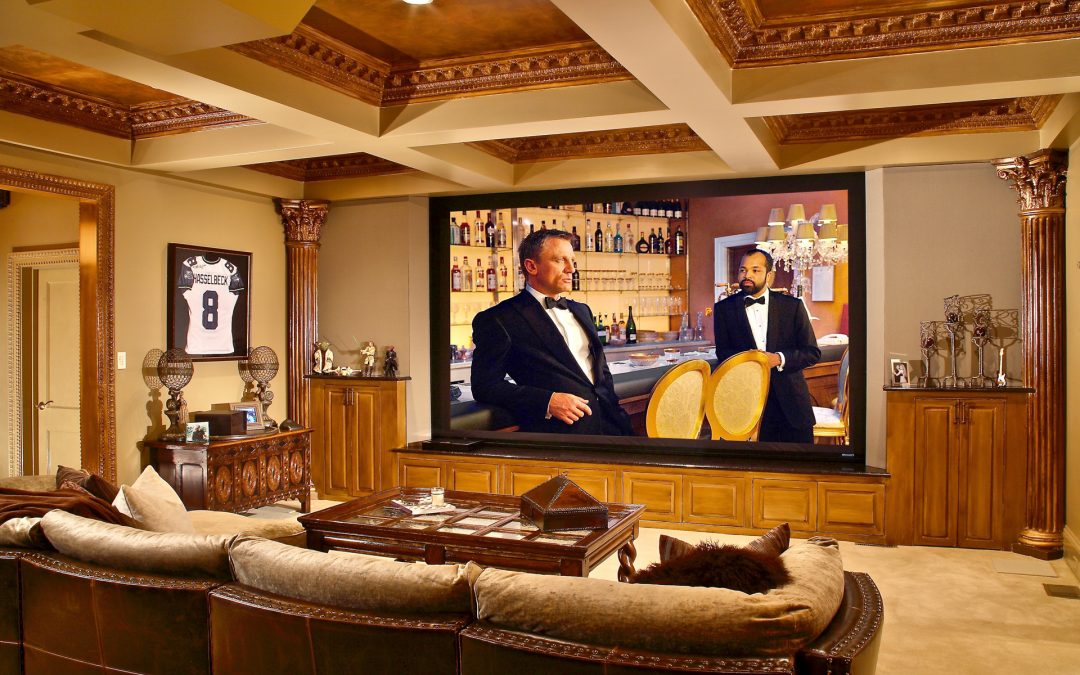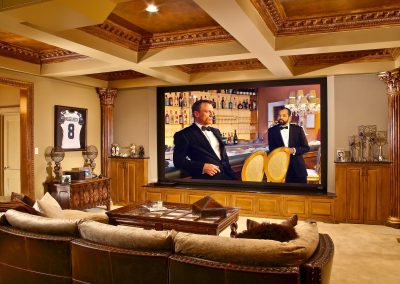By Lynette Ingram Nashville Interiors, Vol. 6 2005-2006
A Grammy-nominated designer of professional recording studios has brought his artistic and technical talents to some of the finest homes in the Nashville area. Thanks to Carl Tatz of Carl Tatz Design, many discerning homeowners and builders are now constructing home screening rooms that will bring a true cinematic experience into their lives.
Though the terms “home theater” and “home screening room” are often used interchangeably, homeowners should be aware of the difference before s/he makes a decision and Contracts with a designer. Carl explains, “A home theater can be simply a compilation of equipment purchased from a retailer, while a home screening room offers the same quality sound and Picture that a Hollywood producer or director might have in their home.”
To create the ultimate home screening room, Carl suggests finding a fully qualified professional to over- see and personally fine-tune every aspect of the process. ‘The goal of the home screening room is to emulate a real Hollywood dubbing stage where motion pictures are mixed for release,” he says. “It should be a total home entertainment environment that integrates your music, media and your home’s interior design. And it should meet your performance expectations.”
A Convertible or Dedicated Room?
Carl consults extensively with his clients to determine their wants and needs for the entertainment space. Every room is unique and Customers can have different expectations. But for any screening room, there are two main options for consideration: a convertible room or a dedicated room.
A dedicated room is the ideal choice for the client who wants the full experience of a Hollywood film in his own home. This type of screening room is structured to take full advantage of advanced audio/visual equipment. Every aspect of the room is designed and computer calculated to enhance sound and picture. For instance, modifying the room dimensions even a few inches can make dramatic sonic improvements and implementing the correct projector, size and type screen and sound system will make the difference between the winners and the also-rans.
Dedicated home screening rooms allow for more flexibility in design on the front end. According to Carl, a dedicated place for screening allows for the proper use of acoustic treatment and speaker/subwoofer placement providing the ideal sound performance to occur. Sound isolation can also be an issue so as not to disturb others in the home and this can be addressed more efficiently in the dedicated room. The shape of a dedicated room is designed for full visual and audio benefits. Carl suggests going for symmetry in the dedicated screening room. For example, a rectangular shape makes it possible to accurately calculate and acoustically treat the room for the best possible acoustics. While dedicated home screening rooms are ideal for those in the process of building or renovating and have the necessary space, not all homeowners are prepared to make that commitment. Those who may have neither the space nor the budget for a dedicated room would probably select a convertible room as an alternative.
A convertible room enhances the enjoyment of picture and sound, but at the same time allows the area to be used as a den or other living space. The actual viewing screen may be invisible when not in use, then activated by the push of a button. Screens may be disguised in one of two ways; using a drop-down screen or covering a fixed screen with a retractable tapestry or a sliding panel. Attractive and non-invasive acoustic treatments can be added to a convertible screening room for a satisfying home viewing experience.
“When I consult with clients on projects, Carl says, “we just start brainstorming to help meet their unique requirements. Any home media provider should provide this service. My customers and I discuss concepts and ideas. Sometimes people are little intimidated by the idea of building home screening room from scratch. They’re worried it will be difficult to use. But the entire system can be programmed into a really reliable and easy-to-use remote control.”
Carl also encourages his clients to read u and learn about home theater and to view lot of home theater photos to help conceptualize how they might want their screening room to look. “I will provide a leather bound portfolio of lots of photos to the client for perusal. I call it the idea book.” For those who are currently building a house, this is the ideal time to designate a screening room. Once all the conceptual issues have been resolved, Carl begins the design process.
Avoiding A Costly Mistakes
Prior to the purchase of home theater equipment, Carl advises his clients to avoid dealing with vendors who will simply try to push certain brands without a working knowledge of how all the components actually work together. For a real home screening room, he believes it’s crucial to find a professional with expertise in not only acoustics, sound system and video design but also with the aesthetic sensibility to create a comfortable and inviting environment.
Generally, retail hi-fi store sales people have limited knowledge and access to the professional audio components needed to create a true screening room,” Carl explains. “As a designer I have complete freedom to choose whatever equipment I feel is best for the particular application and therefore not obligated to sell something because I have it in stock or need to meet a sales quota on a particular piece of gear. Also, as a professional recording studio designer I’ve been able to meld those sonic disciplines into my home screening room designs greatly distinguishing my rooms from the average hi-fi set-ups.” Poor choices can often result in costly disappointments. “Some of the equipment from these hi-fi stores can be very’ expensive and yet because of their “hi-fi” characteristics, inappropriate for movie sound tracks. Add to this the fact that if the sound system is not properly calibrated and tuned the results will be a waste of money making an expensive system sound no better or worse than a cheap system. We see this all the time.”
A True Cinematic Experience
A true cinematic experience is achieved through the symbiotic relationship between the image on the screen and the sound system. To ensure a true cinematic experience, the speakers should be carefully placed behind the screen whenever possible, usually embedded in the wall,” Carl says. “So when you’re viewing the picture, the voices come right out of the screen as they do when you visit a Cineplex. This enhances the temporary suspension of disbelief, which of course is the whole point.”
Appearance and Performance
Two main criteria to consider when designing a home screening room are appearance and performance. Both elements are equally important. In a dedicated screening room, there are numerous choices, from classic to modern, depending on the customers’ tastes. When an interior designer is required Carl will work with either his clients’ interior designer or recommend one with whom he has a working relationship upon the client’s request. “We offer a turnkey solution for the homeowner for the best value and efficiency using contractors who understand and have experience in the nuances of this type of project but can also work with the client’s builders and architects where appropriate. Carl realizes that the process sounds complicated, “But in the end,” he explains, “the homeowner will have a high-quality seamless and complete entertainment system with everything programmed into one simple remote control instead of a jumble of hi-fi equipment and their individual remotes.”
Once your screening room is completed and the projector has been properly calibrated the final step is to phase correct and equalize all the speakers and subwoofers for maximum performance. This can take a couple of days. Correctly tuning a cinema sound system is an art that only a handful of professionals are qualified to do and all have come from the professional audio camp. This is a task that Carl personally performs for his clients. ”I’m very fortunate to have studied with some of the great acousticians and designers over the years,” says Carl. “Quite frankly, there is no one other than myself who offers this skill in Nashville or the Southeast for that matter.” Most AV installers are not aware of what a huge difference this tuning can deliver to there client’s experience because most likely they have never experienced it themselves or have heard it done poorly.
Great Things Do Come In Small Packages. If you lack the area typically needed for a dedicated home screening room, you may want to consider a Mini Home Screening Room designed to work within your current space and budget. This is an ideal alternative for those homeowners who want to take advantage of a small, unused bedroom as well as for those who are living in a condominium. According to Carl Tatz of Carl Tatz Design, “Just because you don’t have a huge room available for a theater-sized screening room, that doesn’t mean you have to give up a true cinematic experience. I can work with any size dimensions or any project budget to meet the specific needs of each client. You don’t have to be deprived of the effect of a home screening room, just because you have a small space”.



